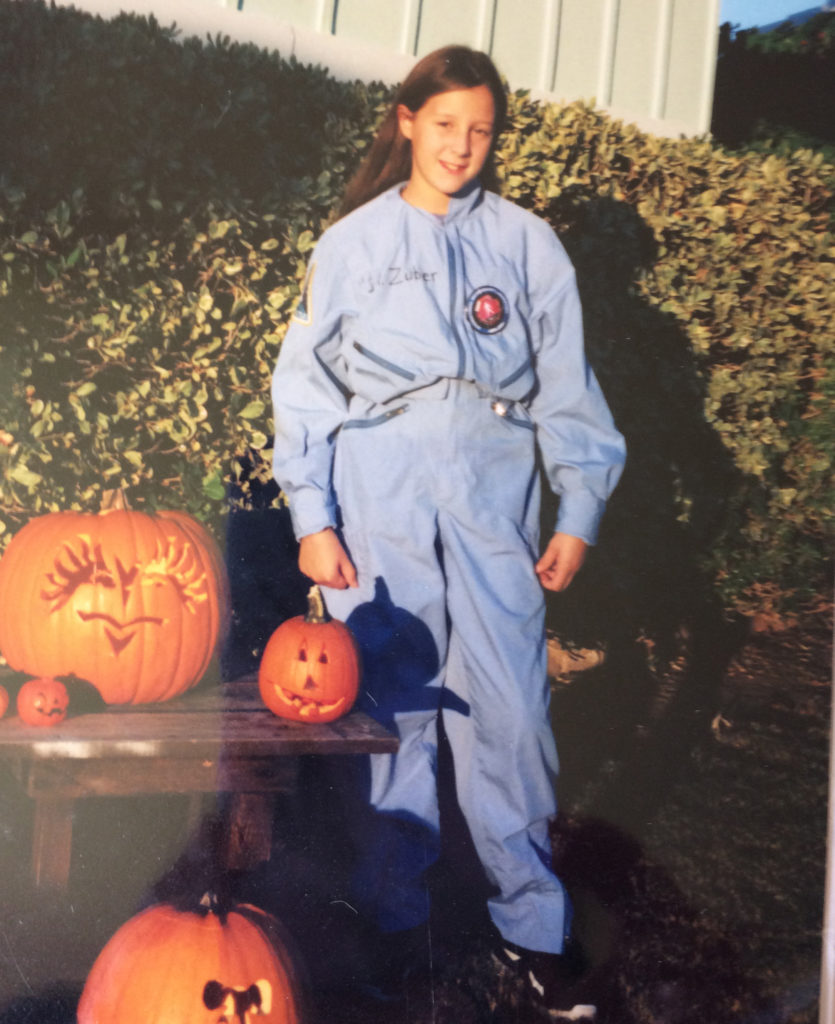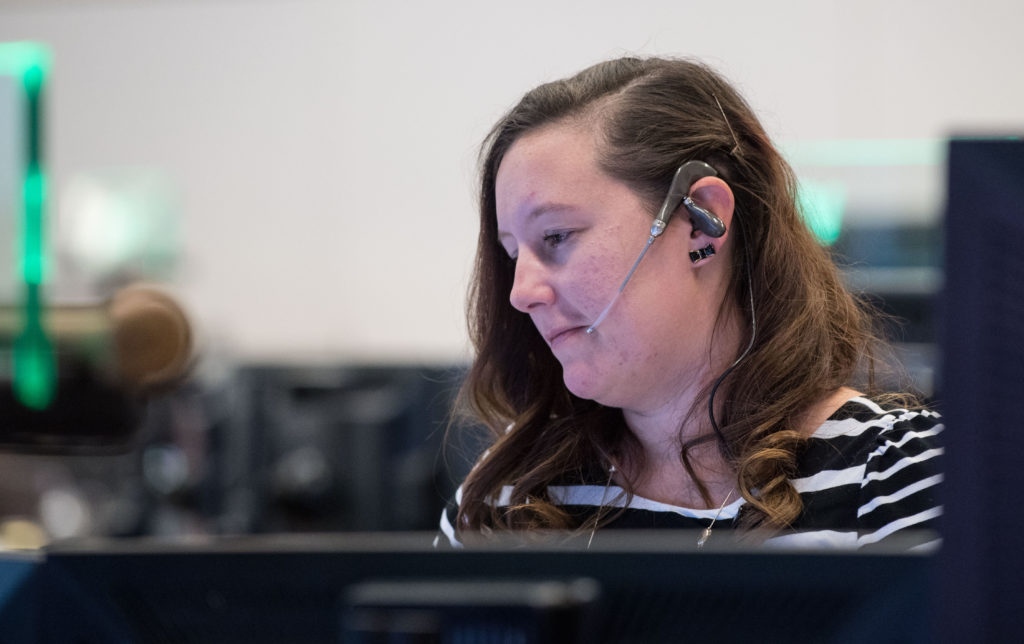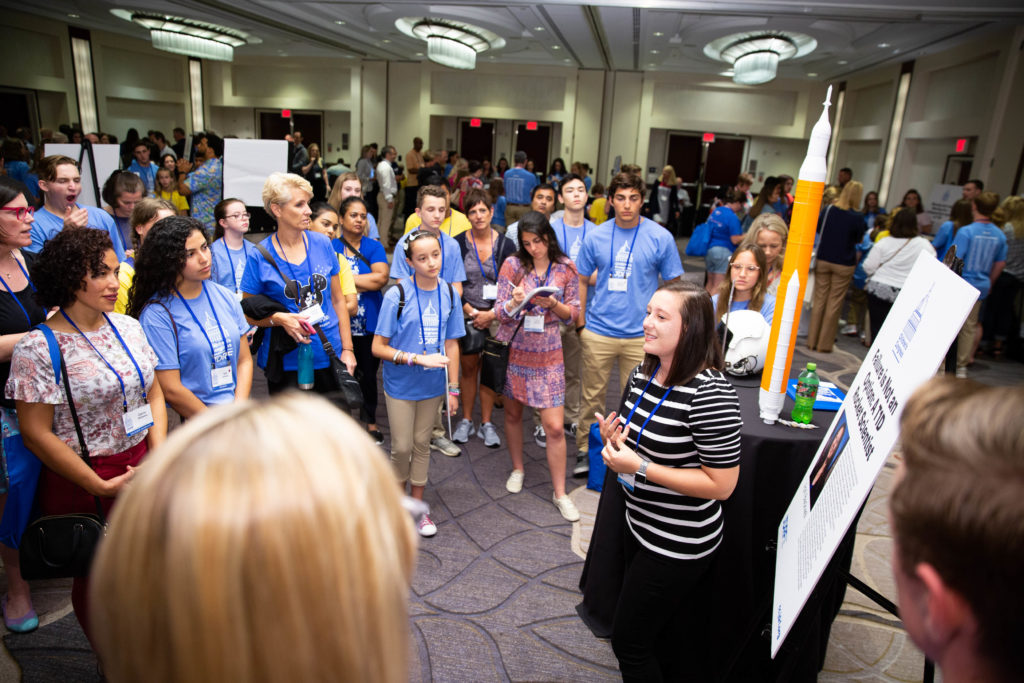Talking NASA with PWD April Blackwell
Ever wonder what it’s like to be part of the space program and managing diabetes at the same time? We had the chance to talk with Aerospace Engineer and NASA Flight Controller, April Blackwell, who has been living with diabetes since 1998.
Children with Diabetes: When were you diagnosed with diabetes, and what was that like for you?
April Blackwell: I was diagnosed in 1998 at age 11. There isn’t a “perfect time” to be diagnosed with diabetes, but I’m happy that I remember what life was like before it hit. The diabetes diagnosis itself marked a turning point in my life – I had to shift my thought process from child to adult. In retrospect, I’m sad that my hand was forced, but in the end I think it was for the best.
Children with Diabetes: What made you want to become an aerospace engineer and did diabetes influence your decision to become involved with the space program?
 April Blackwell: My fascination with space started all the way back around age 6. My dad is an aircraft mechanic and also fascinated with the space program – his excitement wore off on me and I couldn’t get enough. Soon we were planning family trips to space museums all over the country, I checked out every book on space from the school library (and asked for more!), I even got up early on Saturdays not to watch cartoons, but to watch the news, hoping for a quick story on a space shuttle launch (my mom still makes fun of me for this).
April Blackwell: My fascination with space started all the way back around age 6. My dad is an aircraft mechanic and also fascinated with the space program – his excitement wore off on me and I couldn’t get enough. Soon we were planning family trips to space museums all over the country, I checked out every book on space from the school library (and asked for more!), I even got up early on Saturdays not to watch cartoons, but to watch the news, hoping for a quick story on a space shuttle launch (my mom still makes fun of me for this).
As for a career in aerospace – like many kids I dreamed of being an astronaut. This made the diagnosis of type 1 diabetes even worse. Now I was faced with shots and carb counts and lows and highs, finger pricks and snacks, misinformation and judgment, but all I cared about was losing the ability to become an astronaut. Type 1 is an automatic disqualification on the NASA astronaut application.
After lots of wishes on my glow-in-the-dark ceiling stars and tons of encouragement from my family and as much soul searching as one 11-year-old can do, I decided to just go for it anyway. There was nothing else I wanted to do more, I couldn’t imagine a more fulfilling career path, even if it meant working WITH astronauts instead of being one.
Children with Diabetes: What’s a typical day at work like for you? Or is there even a typical day?
April Blackwell: I don’t work in mission control everyday (we rotate shifts), but those are definitely my favorite days, so I’ll share that! My favorite days on console are when dynamic operations are happening – this could be a vehicle docking or undocking, a spacewalk, a reboost, or a cargo vehicle rendezvous. Usually, we have prepared for these events together in a specific team, so its fun to show up on console and see all of the people you have spent hours with simulating the event and double-checking plans. We do a quick handover from the previous shift and then the Flight Director calls on each of us to give a status. He or she gets statuses from the control centers all over the world – Russia, Japan, Munich, Alabama, and Canada. I still get butterflies as we take over the shift and get our console set up. The shifts are normally 9 hours long which is about as long as my concentration can last. During that time I talk to the Flight Director, often my colleagues in Russia, and other controllers in mission control. We send commands up to the space station to make sure everything is set up perfectly for the event – it could be a small attitude adjustment or configuring the thrusters. We execute out of detailed procedures and are always ready for the “next worse failure.” Our priorities are always (1) crew safety, (2) vehicle safety and (3) mission success. We use those priorities to guide our decisions and actions in mission control.
Children with Diabetes: What’s the biggest way that diabetes affects your job?
April Blackwell: Interestingly, diabetes fits so well with my job! If you could see my computer setup there are four large monitors with telemetry from the International Space Station populating readouts and graphs several times a second. We use colors to indicate different thresholds and employ tones to alert us of any off-nominal trends or readings. Does this sound familiar? My CGM graph just becomes another trend in my scan pattern, and when you’re looking at this much data, what’s one more number?
The job does require that I obtain a “Flight Controller Physical” annually. The physical is similar to the FAA’s requirements for an Air Traffic Controller. As a type 1 diabetic, my medical clearance is granted each year via waiver, requiring that I submit letters from my endocrinologist and ophthalmologist detailing my A1c and eye health. I am grateful the NASA doctors (the same ones that interface with the astronauts) look at and assess my data as an individual with diabetes – I’ve never had a problem getting my waiver granted!
Logistically, all of the Flight Directors know I have type 1 diabetes – this is something that is important to me to share. As an integral member of their team, responsible for human lives onboard the space station, I think it is fair that they are aware I will be checking my insulin pump and may need to eat a snack!
Children with Diabetes: Has diabetes ever been an asset in terms of your job?
April Blackwell: Yes! This is the question no one ever asks – but should! I firmly believe that facing the challenge of diabetes head-on, living the mechanics day in and day out, making real-time decisions directly affecting my health constantly has baked in the qualities of a good flight controller (and lots of other jobs too)! NASA is heavy on the history – the founding fathers of the mission control concept set out 7 characteristics or qualities needed by high functioning flight controllers – they are called the “Foundations of Flight Operations”. A plaque hangs in almost every room here at the Johnson Space Center, and the qualities may surprise you – discipline, responsibility, teamwork, confidence, competence, vigilance and toughness. I can’t think of 7 more perfect words to describe the qualities living a life with type 1 diabetes instills – naturally. As type 1 diabetics our brains already have neural pathways to facilitate anomaly resolution, backup plans, and if/then scenarios.


Children with Diabetes: How do you educate about and advocate for diabetes on the job? Outside of work?
April Blackwell: On the job I just don’t hide it. Type 1 diabetes is serious – so are the consequences if something happens and no one around you knows you have it. The great part about working at NASA is that everyone loves numbers! It’s pretty easy to talk about trends and the basics – eat carbs when low, take insulin when high. It’s sometimes hard to break out of that numbers mindset though. As engineers we are generally very logical, data driven people, so it’s hard to explain that sometimes I eat the exact same food item and take the exact same insulin dose, but end up with a completely different blood sugar. My style of advocacy is pretty grassroots – so I like just sticking in a little diabetes education whenever it organically comes up!
Outside of work I am antisocial (hi! I’m an engineer and awkward!), so this translates to sharing and advocating for diabetes via the internet! Of course, I will gladly discuss it if it comes up in conversation – I would much rather talk about it and explain things and answer tons of questions than have someone assume something about me just because of the label “diabetes”.
Children with Diabetes: As a mom, how do explain diabetes to your kids?
April Blackwell: My kids are only 3.5 years and ~18 months, so their view of diabetes is simplified at this point. In general, my oldest knows that my pump has medicine and that occasionally I chug one of those apple-sauce-in-a-bag things we carry around as toddler snacks to treat a low blood sugar. My son is fascinated by insulin pump tubing, so site placement can be tricky. He has heard me yelp when his grabby little fingers tug at that clear tube sticking out of my arm! Low blood sugars generally translate to “mommy doesn’t feel good right now, but she will soon” and diabetes gadgets are just part of bionic mom.
Children with Diabetes: And you’ve been part of the diabetes online community for years – what prompted you to start your blog and why do you continue to share your story on Nerdy April?
April Blackwell: My blog originally started as a way to keep my family informed while I was several states away completing a summer internship. But after I started my first “real” job after college it became a way to connect with other T1s struggling with outdated rules and regulations. On my blog I detailed my saga to get a Class III Medical Clearance through the FAA in order to fly on experimental Army helicopters. I started receiving emails from other aspiring pilots, SCUBA divers, even military candidates all with type 1 diabetes. I answered questions about what order of paperwork and letters and data had worked for me, how to ask questions without getting defensive, and how to educate medical personnel who normally deal with near-perfect specimens.
I think so many people hear the words “waiver” or “doctors letters” or “paperwork” and just give up – feeling defeated because of the extra hoops. But I want there to be a place (albeit tiny) for them to find hope, this is the reason I still blog sporadically (my life has gotten busier!). Sharing these breakthroughs and successes and challenges is a tangible way to connect and inspire – because I hope everyone gets to live out their dreams!


Children with Diabetes: What advice would you give for a young person with diabetes who is excited about space as their career frontier?
April Blackwell: Go boldly! This industry needs you now more than ever – we are on the cusp of commercial space travel, which, I believe, is a pathway for T1D astronauts. But beyond that – beyond astronaut dreams there is so much room for talented space scientists and engineers to work on challenges like returning to the moon, heading on to Mars, sending satellites farther than ever before, using technology to positively impact life on earth, potentially using microgravity to develop cures for diseases, establishing worldwide communication and extending it for deep space missions – the list goes on and on. And as you can see, you aren’t limited to a degree in aerospace engineering to work on these projects!!
Don’t give up – use the qualities type 1 diabetes bakes in to your advantage – I can’t wait to work with you!
Published: November 5, 2019


The CWD Editorial team is always hard at work to bring you the latest in diabetes research and news, as well as the info you need to live well with diabetes.
Do you have a story idea? Email us as [email protected]!
